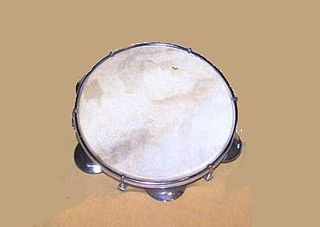


A practice pad or drum pad, is a piece of equipment used by drummers and other percussionists to practice quietly, or to warm up before a performance. [1]



A practice pad or drum pad, is a piece of equipment used by drummers and other percussionists to practice quietly, or to warm up before a performance. [1]
A variety of practice pads have been developed to assist percussionists in different ways. Practice pads may be designed to approximate the tension and response of a true drumhead when struck, or to provide less rebound to train the percussionist’s muscles. They can be constructed in a variety of shapes and sizes, and are typically small and light enough to be easily portable. Many variations include harder or softer playing surfaces, non-skid bases (that can also double as muted playing surfaces), and fixing points allowing the pad to be connected to existing percussion hardware such as a cymbal or snare drum stand. [2]
Some practice pads use a disk of mylar, or another material used in the construction of true drumheads, stretched over a substrate such as foam or rubber. These elements are fixed together by a rim of metal or plastic. [2]
Many other devices use a thin layer of elastomer, such as natural or synthetic rubber of various densities, as a playing surface. This type of rubber surface is either placed directly over the top of an existing drumhead, or stuck to the top of a solid substrate. The rubber is designed to reflect a drumstick or mallet after being struck in a way similar to that of a true drumhead. [3]
Some practice pads use a disk of mesh stretched over a frame. The mesh is quieter when struck than rubber or mylar, and can be tuned to mimic different types of drum head by tightening and loosening it in the frame. [4]
These devices can be placed on a wide variety of surfaces including the player’s lap, a tabletop or the head of an actual drum. Placing the pad on the head of an actual drum can have the effect of transferring to the drum’s natural snare-side response along with severely muting the sound of the drum. Several units are often arranged like a standard drum kit for practice purposes.

The drum is a member of the percussion group of musical instruments. In the Hornbostel-Sachs classification system, it is a membranophone. Drums consist of at least one membrane, called a drumhead or drum skin, that is stretched over a shell and struck, either directly with the player's hands, or with a percussion mallet, to produce sound. There is usually a resonant head on the underside of the drum. Other techniques have been used to cause drums to make sound, such as the thumb roll. Drums are the world's oldest and most ubiquitous musical instruments, and the basic design has remained virtually unchanged for thousands of years.

A drum kit is a collection of drums, cymbals, and sometimes other auxiliary percussion instruments set up to be played by one person. The drummer typically holds a pair of matching drumsticks or special wire or nylon brushes; and uses their feet to operate hi-hat and bass drum pedals.

A percussion instrument is a musical instrument that is sounded by being struck or scraped by a beater including attached or enclosed beaters or rattles struck, scraped or rubbed by hand or struck against another similar instrument. Excluding zoomusicological instruments and the human voice, the percussion family is believed to include the oldest musical instruments. In spite of being a very common term to designate instruments, and to relate them to their players, the percussionists, percussion is not a systematic classificatory category of instruments, as described by the scientific field of organology. It is shown below that percussion instruments may belong to the organological classes of idiophone, membranophone, aerophone and chordophone.

The snare drum is a percussion instrument that produces a sharp staccato sound when the head is struck with a drum stick, due to the use of a series of stiff wires held under tension against the lower skin. Snare drums are often used in orchestras, concert bands, marching bands, parades, drumlines, drum corps, and more. It is one of the central pieces in a drum set, a collection of percussion instruments designed to be played by a seated drummer and used in many genres of music. Because basic rhythms are very easy to learn to play on a snare drum even for children, the instrument is also suitable for the music education for young children and a rhythm band.

The bass drum is a large drum that produces a note of low definite or indefinite pitch. The instrument is typically cylindrical, with the drum's diameter much greater than the drum's depth, with a struck head at both ends of the cylinder. The heads may be made of calfskin or plastic and there is normally a means of adjusting the tension either by threaded taps or by strings. Bass drums are built in a variety of sizes, but size does not dictate the volume produced by the drum. The pitch and the sound can vary much with different sizes, but the size is also chosen based on convenience and aesthetics. Bass drums are percussion instruments and vary in size and are used in several musical genres. Three major types of bass drums can be distinguished.

BoPET is a polyester film made from stretched polyethylene terephthalate (PET) and is used for its high tensile strength, chemical stability, dimensional stability, transparency, reflectivity when metallized, gas and moisture barrier properties, and electrical insulation. The film is "biaxially oriented", which means that the polymer chains are oriented parallel to the plane of the film, and therefore oriented in two axes. A variety of companies manufacture boPET and other polyester films under different brand names. In the UK and US, the best-known trade names are Mylar, Melinex, Lumirror and Hostaphan. It was the first biaxially oriented polymer to be manufactured on a mass commercial scale.

Daniel Edwin Carey is an American musician and songwriter who is the drummer for the progressive metal band Tool. He has also contributed to albums by artists such as Zaum, Green Jellö, Pigface, Skinny Puppy, Adrian Belew, Carole King, Collide, Meat Puppets, Lusk, and the Melvins.

A drumhead or drum skin is a membrane stretched over one or both of the open ends of a drum. The drumhead is struck with sticks, mallets, or hands, so that it vibrates and the sound resonates through the drum.

The pandeiro is a type of hand frame drum popular in Brazil. The pandeiro is used in a number of Brazilian music forms, such as samba, choro, coco, and capoeira music.

Marching percussion instruments are percussion instruments specially designed to be played while moving. This is achieved by attaching the drum(s) to a special harness worn by the drummer, although not all marching bands use such harnesses and instead use traditional baldrics to sling their drums.

Electronic drums are a modern electronic musical instrument, primarily designed to serve as an alternative to an acoustic drum kit. Electronic drums consist of an electronic sound module which produces the synthesized or sampled percussion sounds and a set of pads, usually constructed in a shape to resemble drums and cymbals, which are equipped with electronic sensors to send an electronic signal to the sound module which outputs a sound. Like acoustic drums, the pads are struck by drum sticks and they are played in a similar manner to an acoustic drum kit, albeit with some differences in the drumming experience.

V-Drums are a line of electronic drums by Roland Corporation which were first launched in 1997.

The Basel drum is a two-headed rope-tension drum. It takes its name from its origin in Basel. This percussion instrument is best known from the Carnival of Basel, where it is played by more than 2000 drummers. They are called Tambouren in Swiss German or Tambourins in French. There is no typical number of players for marching-bands including this instrument. Anything between three and fifty drummers may be seen in such a formation.

Remo Inc. is an American musical instruments manufacturing company based in Valencia, California, and founded by Remo Belli in 1957. Products manufactured include drum kits, drumheads, drums, and hardware, and various percussion instruments.

Simmons is an electronic drum brand, which originally was a pioneering British manufacturer of electronic drums. Founded in 1978 by Dave Simmons, it supplied electronic kits from 1980 to 1998. The drums' distinctive, electronic sound can be found on countless albums from the 1980s. The company closed in 1999 and the Simmons name is currently owned by Guitar Center.

An electronic drum module is an electronic or digital music device in an electronic drum kit that serves as the central processing unit and sound module. The drum module creates or produces the drum kit sounds or other sounds selected by the drummer. By itself, a drum module cannot play or sound drum beats. It only produces drum sounds when a performer strikes electronic drum pads or acoustic drum kit instruments that have electronic "triggers" attached to them. When the electronic drum pads or trigger-equipped instruments are struck, this sends a signal to the drum module, which produces the corresponding electronic drum sound. Even when drum pads and/or triggers are connected to a drum module, the drum module by itself does not make any audible sound. Like other electronic instruments such as the synthesizer, the drum module only outputs an electronic signal. The performer can hear this signal by connecting headphones to the drum module or by plugging the drum module into an amplifier and loudspeaker or PA system for audible practice or live performances. The drum module's output signal can also be patched into an audio console for concerts or sound recording. The nomenclature varies. For example, electronic drum modules are called "percussion sound modules" in the case of Roland Corporation, or sometimes simply modules. A common colloquial term for this device is drum brain..

Drum hardware is the set of parts of a drum or drum kit that are used to tension, position, and otherwise support the instruments themselves.

In percussion, grip refers to the manner in which the player holds the sticks or mallets, whether drum sticks or other mallets.
The DrumIt Five is an electronic drum line produced by 2box, a Swedish company started by former employees of ddrum. The kit is based on tunable mesh drum heads, similar to Roland's V-Drum line. The focus of its design is to produce more natural sounds than are characteristic of most electronic drum kits on the market.
Drum tuning is the process of adjusting the frequency or pitch of a drum. Although most drums are unpitched instruments, they still have a fundamental pitch and overtones. Drums require tuning for a variety of reasons: to sound good together as a kit, to sound pleasing as an individual drum, to achieve the desired amount of ringing and resonance, and to produce the sound that fits the music. Some drums such as timpani and rototoms are tuned to a definite pitch. Drums are tuned by tightening or loosening the tension rods or ropes, which control the tension on the drumhead. Additional techniques such as muffling may also be used to affect resonance.